Types of Basil to Grow in Your Garden

This post follows our research editorial guidelines.

Often touted as the “King of Herbs,” the versatile basil is an excellent (and popular) addition to any garden. Nothing beats the aroma of freshly pruned basil in your tomato sauce or a generous topping of torn-up basil over piping hot pizza.
Basil is a mainstay in Italian cuisine, from pasta sauce to homemade pesto to Caprese salads. There is no way to escape this well-loved herb (not that I would ever want to). Whether your growing basil indoors using an AeroGarden or outdoors in the sun this growing guide is for you!
The great thing about this culinary herb is it is just as delicious whether used fresh or dried. When introduced to colder temperatures, basil (an herb that prefers warmer climates) wilts, but you can still enjoy it dried in your Italian seasoning or sprinkle it over pasta. According to Native Plant Specialist Shirley Mah Kooyman, “Preserve [basil] leaves by hanging the foliage upside down in small bunches. Air dry in a warm, dry, well-ventilated room for a week.”
Apart from its culinary usage, basil provides a range of other benefits. It makes an excellent companion plant to ward off pests. You can use it to relieve headaches, and it is popular in aromatherapy. Basil tea can also help in digestion and stress reduction.
Safe to say, basil is one popular herb, and for a good reason. However, many people do not know that basil has impressive and equally delicious varieties that you can choose to grow in your garden to enjoy fresh when you feel like it.
Here, I will discuss all the different kinds of basil you can (and should) grow in your garden.
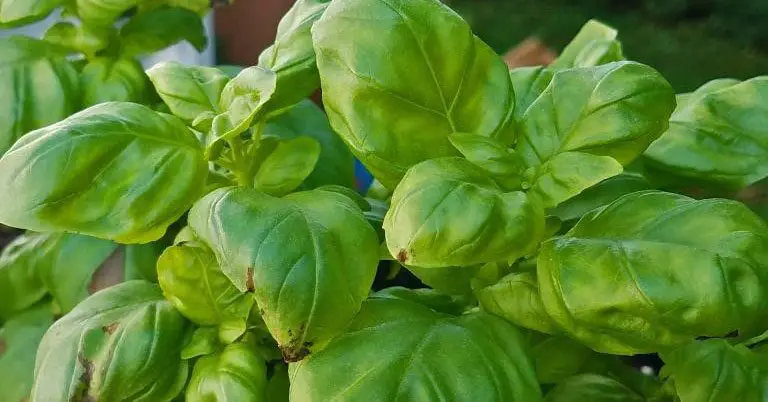
Table of Contents
Sweet Basil
If you have only had one variety of basil, it can be a safe bet that it was sweet basil. Referred to as simply “basil,” this is what you usually get at the grocery. It can be used in pesto, marinades, salads, or to tear and use as a topping for pizza.
In other words, this is good for nearly everything, thus making it a great choice to have in your garden.
All you need is a place with full sun (a brilliant placement idea would be a windowsill) and well-drained soil.
Genovese Basil
Genovese basil looks a lot like sweet basil and can be used in many traditional Italian dishes. This bright green-leaved basil variety loves the sun just as much as sweet basil.
It has a more potent flavor in comparison to sweet basil, with a floral and sweet aroma. You can plant it in a container or a prepared garden bed. It can reach almost 16 – 18 inches, spreading 12 to 16 inches in width.
Sweet Thai Basil
Sweet Thai basil, with its narrow leaves and purple flowers, is used in an array of Asian dishes because of its unique flavor profile, which could be described as licorice-like with spicy undertones. This type of basil is excellent for cooking as it can hold its own against high temperatures, while some of the other basil varieties tend to lose their aroma.
Like its sister varieties, Sweet Thai basil thrives in sunny locations when planted in moist soil. Take care not to overwater the soil while maintaining moisture.
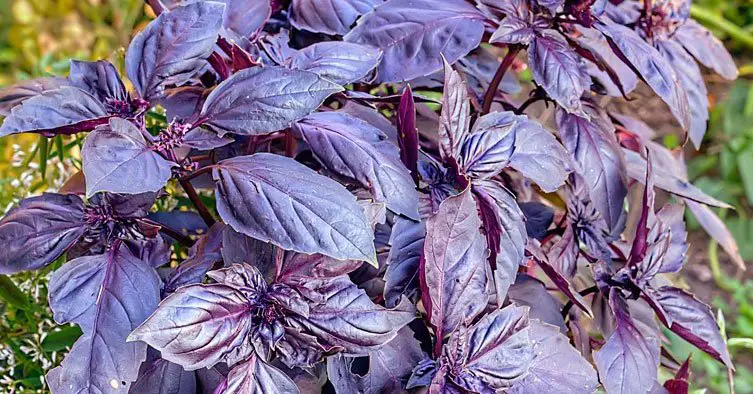
Purple Basil
Purple basil is an annual herb that can grow up to 20 inches when mature. With its strong smell and striking purple-colored leaves, it adds a great contrast to your herb garden and to your dishes, whether as a garnish or the main ingredient. It has an intense sweet-spicy flavor.
Different varieties of purple basil thrive in sunny but sheltered spots and loamy, sandy soil that is well-drained. Watering this type of basil in the morning is a good idea to avoid excessive moisture during nighttime.
Italian Large Leaf Basil
True to its name, this type of basil has shiny green leaves that can grow quite large – up to 3 inches. It can grow anywhere between 18 inches to 24 inches when it reaches maturity in 75 days.
It has a potent sweet aroma (so much so, you can smell it from afar in the garden) and a sweeter and milder taste than Genovese basil. It can be used fresh or cooked down in a variety of Neapolitan dishes.
Napolitano Basil
If you want to stick to your sweet basil flavor but prefer a little spicy kick to your food, Napolitano basil will be an excellent addition to your garden.
This basil has light green, crinkled leaves that can grow up to 12 centimeters, making them quite large compared to other sweet basil varieties. This variety makes an excellent choice for pesto due to its large leaves and slightly spicy yet mild flavor you generally associate with basil herb.
Lemon Basil
Citrus undertones in this variety of basil make it a true treat to be used in marinades and paired with seafood. Crushing the leaves gives out an exquisite lemony scent that is unique to Lemon basil.
This basil has light green leaves with a distinctive aroma that makes it a must-grow option for your garden if you enjoy various herbs. Lemon basil requires a minimum of six hours of sun. It would be prudent if you watered the herb to prevent the topsoil from drying out.
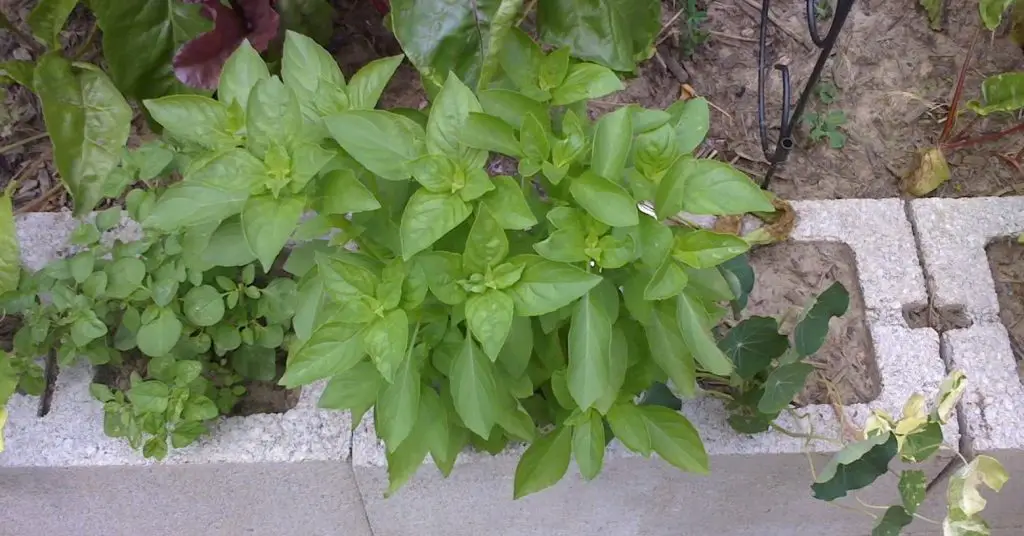
Lime Basil
Lime basil is another welcome addition to any herb garden to add a distinct taste profile that differs from the traditional sweet basil. When chopped or minced, this basil type gives out a peppery-lime scent. You can use lime basil in various dishes; however, too much heat can diminish its unique flavor.
Like most other basil types, lime basil needs to be planted in well-drained soil in a place where it can be under six hours of sunlight per day.
Holy Basil
This jagged-leaved basil variety is native to India and is widely used for its medicinal benefits. Bitter with a numbing sensation when eaten raw, this peppery, pungent variety is a part of many Thai and Southeast Asian recipes. It has undertones of black pepper and cloves and thus is more flavourful when cooked down.
It needs full sun to grow to its full potential when planted in well-drained soil.
Greek Basil
Greek basil’s small leaves (it only grows up to 8 inches) make it the perfect basil variety to be grown inside containers or little pots.
It is aromatic with different kinds having underlying flavors of pepper, anise, and mint. You can pair it with tomatoes or use it atop salads to garnish for an added layer of complex flavor. Its delicate leaves make it an excellent countertop herb and flower garden attraction.
Ideal growing conditions for Greek basil include a window sill pit that receives bright sunlight. If you live in a warmer state, it is recommended to provide shade during the afternoon sun.
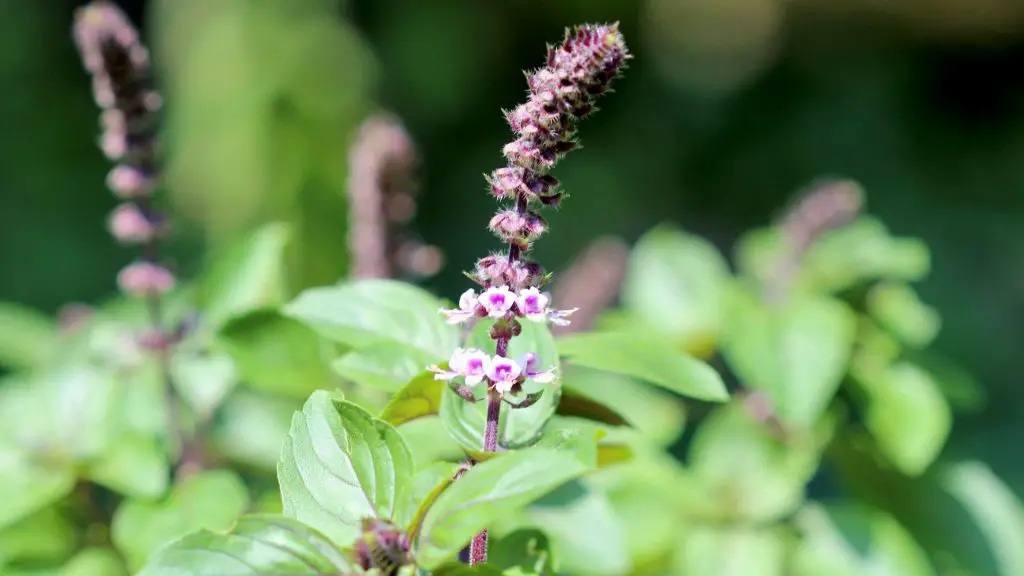
African Blue Basil
African blue basil, with its striking purple blooms, is part of many bespoke flower arrangements. Being one of the tallest basil varieties, this hybrid type between camphor and dark opal basil can grow up to a tremendous 4 feet.
The presence of camphor makes it a common ingredient in beauty and skincare products. It is also used in several meat and vegetable dishes because of its earthy and musky flavor. You can also taste notes of menthol and cloves in this particular type. Another unique quality of this basil type is that it is a sterile perennial that can grow through cuttings.
Cinnamon Basil
As distinctive as the spicy cinnamon flavor of Cinnamon basil is, it is an acquired one. If you do not like the taste of cinnamon as a spice, chances are this basil variety is not for you.
However, you can make many desserts with this basil type as it pairs exceptionally well with fruit. You will also find it recurring in many Asian cookbooks, where it is used in marinades and stir fry noodle salads.
To grow cinnamon basil, ensure 6 hours of sunlight per day in well-drained soil.
Spicy Globe Basil
Just as the name suggests, this small-leaved basil variety grows into a neat, bushy “globe” like shape. It adds a fantastic zing when added whole as a garnish to soups and salads because of its spicy flavor. You can preserve this basil variety by drying it without compromising on the taste.
It is an excellent choice to grow Spicy Globe basil in containers indoors. Its ¼-inch long leaves can only grow between 6 to 10 inches.

Christmas Basil
This pleasant fruity-smelling basil variety is a cross between Thai basil and Genovese basil. It has pointed dark leaves. Christmas Basil can grow up to 16 inches tall when it reaches maturity. You can use it to make pesto, salads, and several drinks because of its fruity taste. Apart from its culinary use, Christmas basil works excellent as an ornamental plant in garden beds.
Christmas basil is particularly forgiving when it comes to soil pH. The only condition is that it shouldn’t dry out. Like other basil varieties, it likes warm weather and plenty of sunlight.
Summerlong Basil
Summerlong basil, like its name, can be produced all summer. This dwarf variety basil is an excellent fit for a container and reaches maturity in 1 to 2 months because of its small size. Summerlong Basil is an annual herb that can also be used as vegetable bed edging. It requires total exposure to sunlight to grow properly.
It has the same flavor profile as sweet basil. You can use it to make flavorful pesto and pasta and as a garnish to add freshness to salads.
Cardinal Basil
Even if you haven’t tasted this spicy basil variety, Cardinal basil is so gorgeous that it is impossible to miss because of its striking red blooms. Cardinal basil can grow up to two and a half feet. Since this type of basil has sturdy steam, you can easily place it at the back to add ornamental value if you have an outdoor garden.
Its spicy flavor and scent make it the best choice to infuse oils and vinegar. Cardinal basil seeds should be planted when there is no chance of frost. After 1 to 2 weeks of being packed in moist soil, the seeds should produce Cardinal basil seedlings.
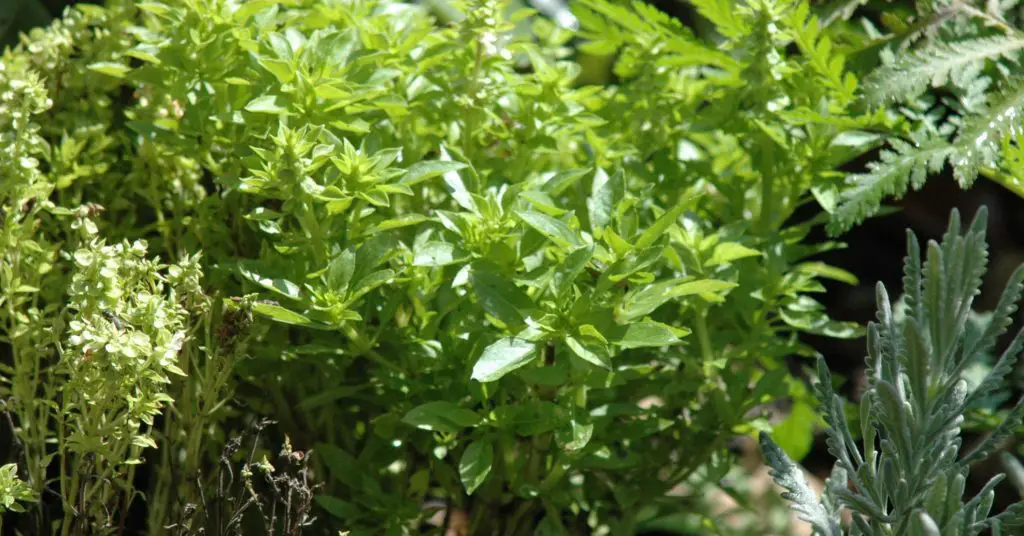
Spicy Bush Basil
Spicy Bush basil is another dwarf variety basil well-suited for indoor containers. It grows into a compact bush. This type of basil has a spicy kick to top the sweet basil flavor. It has small shiny green leaves that grow into a beautiful tight round top.
You are spoilt for choice when planting this extraordinary herb in your garden with so many basil varieties. This herb adds excellent value to your garden, from different flavor profiles to medicinal uses or simply for ornamental purposes.
I have tried to break down different varieties based on how they can feature in your cooking and garden to help you make the increasingly tricky choice of planting just one or two kinds of basil – not that you have to. Basil is a great herb to experiment with within your garden and add heaps of flavor to your daily cooking.
